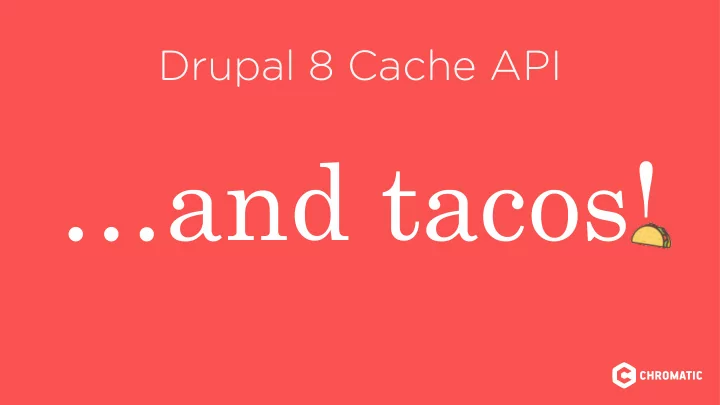

Drupal 8 Cache API …and tacos!
Who? Originally from Toronto, Canada Lives in Tallinn, Estonia Drupal since 2008 Works for Chromatic!
https:/ /chromatichq.com @ChromaticHQ
What is Chromatic? Mostly Drupal-focused with Front End and DevOps expertise Been around for over 10 years Distributed (No head office. No office, period.) https://chromatichq.com Taco time…
Drupal 8 Cache API …and tacos!
Why cache at all? • Buy a Big Mac or buy the ingredients and make one at home? • Minutes vs Hours • Cached page vs Non-cached page • Milliseconds vs Seconds • 281 milliseconds vs 2.97 seconds on my local
Drupal render arrays • Render arrays are the building blocks of a Drupal page • Introduced in Drupal 7 and allow for flexibility in extending / altering / overriding parts of the page • print render($content); • It's important that our render array - the thing that renders the HTML - knows to cache itself • From D.O. : ”It is of the utmost importance that you inform the Render API of the cacheability of a render array." - From Cacheability of Render Arrays* * https://www.drupal.org/docs/8/api/render-api/cacheability-of-render-arrays
Originally a blog post
Got Slack? Get HeyTaco! • HeyTaco! is an integration app for Slack • You hand out tacos to show appreciation and HeyTaco! keeps track of who gets them and how many they have. • 5 tacos to hand out each day.
HeyTaco! in Slack looks like this
HeyTaco! API
What’s the plan? • drush core-quick-drupal (“qd”, “cutie”) • Drupal 8 custom module creates a Block • Custom code grabs leaderboard from HeyTaco! API (https://github.com/ ChromaticHQ/heytaco ) • Use D8 Cache settings to cache it separately for each user • Add bonus tacos to the bosses’ totals to make them think they’re great • A bit of Twig to theme it (heytaco-block.html.twig)
Partner vs Non-partner Leaderboards
HeyTaco Leaderboard block
#cache property’s metadata • keys • contexts • tags • max-age
keys • From Drupal.org : ...what identifies the thing I'm rendering? • This is the "what", as in "What entity is being rendered?” • Can be more than a single string • Cache keys must only be set if the render array should be cached
contexts • From Drupal.org : Does the representation of the thing I'm rendering vary per ... something? • This is the "which", as in, "Which version of the block should be shown?” • Contexts aren't just user-based; they can also be based on cookies ip theme timezone url and more…modules can also define their own (https://www.drupal.org/docs/8/api/cache-api/cache- contexts) • There is a list of cache contexts in core.services.yml
tags • From Drupal.org : What data does it depend upon, so that when that data changes, so should the representation? • String, cannot contain spaces, generally in the form <entity type>:<entity ID> • Can be in sets: [‘user:3’, ‘user:4’, ‘user:5’]
max-age • Max amount of time to cache this rendering • Measured in seconds (3600 = 1 hour) • Defaults to forever (Cache::PERMANENT)
Helpful Info from D.O. From D.O.* : Cache contexts , tags and max-age must always be set , because they affect the cacheability of the entire response. Therefore they "bubble": parents [ie. the page that contains our Hey Taco block] automatically receive them. and… Cache keys must only be set if the render array should be cached. * https://www.drupal.org/docs/8/api/render-api/cacheability-of-render-arrays
Theming
Theming
heytaco.module
heytaco-block.html.twig
In Cache-tastic Conclusion • Cache metadata: keys, contexts, tags, max-age • Render arrays and the #cache property go hand in hand • Try different use cases to better grasp what each metadata piece does • Sample code: https://github.com/ChromaticHQ/heytaco
Thanks! Märt Matsoo twitter @mmatsoo Chromatic https://chromatichq.com
Recommend
More recommend